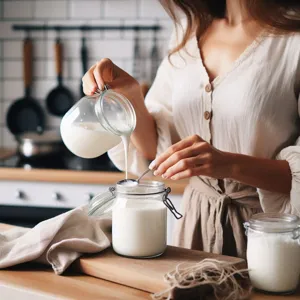In a world where dietary preferences and restrictions are becoming increasingly common, finding delicious meals that cater to diverse needs can be a challenge—especially when it comes to dairy.
Whether you’re lactose intolerant, following a vegan lifestyle, or simply looking to reduce your dairy intake, embracing a dairy-free diet doesn’t mean sacrificing flavor or satisfaction. In this post, we invite you to explore ten must-try recipes that will tantalize your taste buds from breakfast to dinner and everything in between. With an array of vibrant ingredients and creative pairings, these dishes prove that living dairy-free can be both delectable and fulfilling. Join us as we dive into a culinary adventure that celebrates the richness of plant-based cooking, ensuring that every meal is not only nutritious but also utterly delicious. Get ready to redefine your dining experience with these mouthwatering recipes that everyone—dairy lovers and non-lovers alike—will want to savor!
1. Introduction to Dairy-Free Cooking

In recent years, the world of culinary delights has embraced a vibrant shift towards dairy-free cooking, inviting everyone—from the lactose intolerant to the health-conscious and environmentally aware—to explore a myriad of flavors without sacrificing taste or texture. Whether you’re looking to enhance your diet, alleviate digestive discomfort, or simply experiment with new ingredients, dairy-free cooking can open up a treasure trove of delicious possibilities.
At its core, dairy-free cooking encourages creativity and innovation. Gone are the days of feeling limited by traditional recipes that rely heavily on butter, cream, and cheese. Instead, you can harness the power of plant-based alternatives that not only provide the creaminess and richness often craved in dishes but also introduce exciting new flavors. Think creamy coconut milk, rich cashew cream, and tangy almond yogurt—each a fantastic substitute that can elevate your meals to new heights.
Moreover, embracing a dairy-free lifestyle often leads to a renewed appreciation for whole foods. Fresh fruits, vibrant vegetables, hearty grains, and protein-packed legumes take center stage, creating a colorful palette of ingredients that nourish both the body and the soul. With a little knowledge and the right recipes, you can whip up breakfast, lunch, dinner, and even dessert that delights the palate while aligning with your dietary choices.
In this guide, we’ll delve into 10 must-try dairy-free recipes that cater to every meal of the day. From hearty breakfasts to savory dinners and indulgent desserts, you’ll discover that dairy-free cooking is not just a trend, but a delicious adventure waiting to be savored. So grab your apron, let go of any preconceived notions about dairy-free eating, and get ready to transform your kitchen into a haven of mouthwatering, dairy-free delights!
2. Benefits of a Dairy-Free Diet
Adopting a dairy-free diet can bring a myriad of benefits that extend beyond just avoiding lactose. For many, it’s a journey towards better health and enhanced well-being. One of the primary advantages is the reduction of digestive issues. For those who are lactose intolerant or have dairy allergies, eliminating dairy can alleviate bloating, gas, and stomach cramps, allowing for a more comfortable digestive experience.
Moreover, a dairy-free diet is often linked to clearer skin. Many individuals report improvements in acne and other skin conditions after cutting out dairy, as dairy products can sometimes trigger inflammation and hormonal fluctuations that affect skin health. By opting for dairy alternatives, you might find that your complexion becomes brighter and healthier.
Additionally, many dairy-free alternatives are rich in nutrients that can be beneficial for overall health. Plant-based milks, such as almond, oat, or coconut milk, are often fortified with vitamins D and B12, as well as calcium, making them excellent substitutes for traditional dairy. These alternative sources can support bone health while also introducing a variety of flavors and textures to your meals.
Another significant benefit of going dairy-free is the opportunity to explore a diverse range of foods. With dairy off the table, you’re encouraged to get creative in the kitchen, experimenting with ingredients like nuts, seeds, and legumes to create rich and satisfying dishes. This culinary adventure can lead to discovering new favorite recipes and flavors that you may not have tried otherwise.
Lastly, many people who choose a dairy-free lifestyle find that it supports their individual dietary goals, whether that’s weight loss, improved energy levels, or reduced inflammation. By focusing on whole, plant-based foods, you may find it easier to maintain a balanced and nutritious diet that aligns with your health objectives.
In summary, a dairy-free diet offers numerous benefits, from digestive comfort and clearer skin to enhanced nutrition and culinary creativity. Embracing this lifestyle change can lead to a more vibrant, health-focused way of living.
3. Breakfast Recipes

When it comes to breakfast, the first meal of the day sets the tone for what’s to come, and with dairy-free options, you can indulge without compromise. Whether you’re looking for a quick grab-and-go solution or a leisurely morning feast, these delicious recipes will leave you satisfied and energized.
**1. Creamy Coconut Chia Pudding**
Start your day with a delightful bowl of coconut chia pudding. Combine almond milk with chia seeds, a splash of vanilla extract, and a hint of maple syrup. Let it sit overnight in the fridge to thicken, and in the morning, top it with fresh berries, sliced banana, and a sprinkle of toasted coconut for a tropical twist.
**2. Savory Avocado Toast**
Elevate your breakfast routine with a slice of whole-grain bread topped with smashed avocado, a drizzle of olive oil, and a sprinkle of sea salt. For an added boost, layer on some sliced tomatoes, radishes, or a handful of arugula. This dish is not only dairy-free but also packed with healthy fats and nutrients.
**3. Fluffy Vegan Pancakes**
Who can resist pancakes? Whip up a batch of fluffy vegan pancakes using a blend of oat flour, baking powder, almond milk, and a mashed banana for sweetness. Cook until golden brown and serve with a drizzle of pure maple syrup and a handful of fresh fruit. These pancakes are light, airy, and utterly delicious.
**4. Smoothie Bowl Extravaganza**
Kickstart your morning with a vibrant smoothie bowl! Blend your favorite fruits—like bananas, berries, and spinach—with a splash of coconut water or almond milk. Pour it into a bowl and top with granola, sliced fruits, chia seeds, and a handful of nuts. This colorful breakfast is as nutritious as it is Instagram-worthy.
**5. Savory Tofu Scramble**
For a hearty breakfast, try a savory tofu scramble. Crumble firm tofu into a skillet and sauté with diced bell peppers, onions, and a sprinkle of turmeric for that golden hue. Serve it on a warm tortilla or with a side of whole-grain toast for a filling, protein-packed meal.
**6. Overnight Oats with Almond Butter**
Prepare overnight oats for a quick and nutritious breakfast. Combine rolled oats with almond milk, a spoonful of almond butter, and a dash of cinnamon. Let it soak overnight, and in the morning, add your favorite toppings—think sliced apples, a drizzle of honey, or a handful of nuts.
These breakfast recipes not only cater to your dairy-free lifestyle but also promise to uplift your mornings with vibrant flavors and nourishing ingredients. Start your day off right, and let these dishes inspire a deliciously dairy-free routine!
– 3.1 Creamy Coconut Chia Pudding
### 3.1 Creamy Coconut Chia Pudding
Indulging in a bowl of Creamy Coconut Chia Pudding is like treating yourself to a tropical getaway, all from the comfort of your home. This delightful dish is not only dairy-free but also bursting with flavor and packed with nutrients, making it the perfect addition to your breakfast menu or a satisfying snack any time of day.
To create this luscious pudding, start by combining chia seeds with creamy coconut milk, which lends a rich, velvety texture and a subtly sweet, nutty flavor. As the chia seeds soak in the liquid, they expand and form a delightful gel-like consistency that is both satisfying and filling. For an added layer of sweetness, consider stirring in a drizzle of pure maple syrup or a splash of vanilla extract to elevate the taste.
After letting the mixture sit in the refrigerator for at least four hours (or overnight for optimal results), you’ll be greeted with a beautifully thick pudding that can be dressed to your heart’s content. Top it with fresh fruits like ripe mango slices, juicy strawberries, or a handful of blueberries for a burst of color and natural sweetness. A sprinkle of toasted coconut flakes can add a delightful crunch, while a dash of cinnamon gives it a warm, inviting aroma.
Not only is this Creamy Coconut Chia Pudding a feast for the eyes, but it’s also a powerhouse of nutrition. Chia seeds are loaded with omega-3 fatty acids, fiber, and protein, making this dish a heart-healthy choice. Whether you enjoy it as a breakfast option, a mid-afternoon pick-me-up, or even a guilt-free dessert, this recipe promises to satisfy your cravings while keeping things deliciously dairy-free. Dive into this creamy delight, and you’ll find that healthy eating can taste just as indulgent as it sounds!
– 3.2 Vegan Banana Pancakes

When it comes to breakfast, few things are as comforting and satisfying as a stack of warm pancakes. But for those following a dairy-free lifestyle, traditional pancakes often feel like a distant memory. Enter Vegan Banana Pancakes, a delightful twist that not only honors the classic breakfast dish but elevates it to new heights of flavor and nutrition.
These pancakes are incredibly easy to whip up, requiring just a handful of ingredients that you probably already have on hand. Ripe bananas serve as the star ingredient, lending natural sweetness and moisture that replaces eggs and dairy. Simply mash one or two ripe bananas in a bowl, and let their creamy texture work its magic. To enhance the flavor, you can add a splash of almond milk or any plant-based milk of your choice, along with a drizzle of maple syrup for that extra touch of sweetness.
Next, combine your mashed bananas with flour—whole wheat or gluten-free options work beautifully—and a pinch of baking powder for that perfect rise. The result? Fluffy, golden pancakes that are not only pleasing to the eye but also to the palate. To take these pancakes to the next level, consider tossing in a handful of dairy-free chocolate chips or fresh berries into the batter before ladling it onto the hot skillet.
Cooking these pancakes is a breeze; just pour the batter onto a preheated non-stick pan and watch as they bubble up, signaling that it’s time to flip. The aroma wafting through your kitchen will have everyone eagerly anticipating breakfast.
Serve your Vegan Banana Pancakes stacked high, drizzled with more maple syrup, sprinkled with chopped nuts, or topped with a dollop of dairy-free yogurt. Whether enjoyed on a lazy Sunday morning or as a quick weekday breakfast, these pancakes are sure to please both vegans and non-vegans alike. With each bite, you’ll savor the sweetness of bananas and the joy of a deliciously dairy-free start to your day.
4. Lunch Recipes
When it comes to lunch, finding satisfying options that are both nourishing and dairy-free can elevate your midday meal from mundane to magnificent. Here are some enticing recipes that promise to tantalize your taste buds while keeping your diet free from dairy.
**1. Creamy Avocado and Chickpea Salad**
This vibrant salad combines the rich creaminess of ripe avocados with protein-packed chickpeas, tossed in a zesty lemon-tahini dressing. Add in some colorful bell peppers, fresh cilantro, and a sprinkle of hemp seeds for a nutritious boost. Serve it on a bed of mixed greens or as a hearty filling in a whole grain wrap.
**2. Quinoa and Black Bean Bowl**
Wholesome quinoa forms the base of this nutrient-dense bowl, complemented by black beans for a hearty texture. Top it off with roasted corn, diced tomatoes, and a drizzle of avocado-lime dressing. It’s a filling option that’s perfect for meal prep, allowing you to enjoy a fresh bowl throughout the week.
**3. Zucchini Noodles with Pesto**
Spiralized zucchini takes center stage in this light and refreshing dish. Tossed with a homemade dairy-free pesto made from basil, garlic, walnuts, and nutritional yeast, this meal is both vibrant and satisfying. Add cherry tomatoes and grilled chicken or tofu for extra protein.
**4. Mediterranean Wrap**
This wrap is a celebration of Mediterranean flavors, featuring roasted vegetables, olives, and hummus all rolled up in a whole grain tortilla. With each bite, you’ll enjoy a delightful mix of textures and tastes, making it a perfect option for a quick lunch on the go.
**5. Thai Peanut Sweet Potato Buddha Bowl**
This bowl is a delightful combination of roasted sweet potatoes, sautéed broccoli, and crunchy carrots, all drizzled with a creamy homemade peanut sauce. The balance of sweet and savory flavors will leave you feeling energized and satisfied, making it an excellent choice for a midday recharge.
These lunch recipes are not only delicious but also easy to prepare, ensuring that you can enjoy nourishing meals without the hassle. Each dish is packed with wholesome ingredients that will keep you satiated and ready to tackle the rest of your day, all while embracing the benefits of a dairy-free lifestyle.
– 4.1 Quinoa and Black Bean Salad

### 4.1 Quinoa and Black Bean Salad
Quinoa and black bean salad is a vibrant, nutrient-packed dish that perfectly embodies the essence of a deliciously dairy-free lifestyle. This refreshing salad is not only bursting with flavor but also offers a hearty texture that makes it a satisfying option for lunch or dinner.
To start, you’ll need to cook your quinoa until it reaches a fluffy consistency, which serves as the foundation of this colorful salad. As the quinoa cools, prepare your black beans—canned varieties work wonderfully, just remember to rinse and drain them to reduce sodium levels. Next, chop up a rainbow of fresh vegetables: crisp bell peppers, zesty red onions, and juicy cherry tomatoes add not only color but also a crunch that complements the softness of the quinoa and beans.
To elevate this dish further, a simple dressing of olive oil, lime juice, minced garlic, and a sprinkle of cumin brings everything together with its tangy and aromatic flair. Toss in some chopped cilantro for a fresh herbaceous note, and you have a salad that is as visually appealing as it is delicious.
This quinoa and black bean salad is incredibly versatile; it can be served on its own, as a side dish, or even as a filling for lettuce wraps. Plus, it stores beautifully in the fridge, making it a perfect meal prep option for those busy weekdays. Packed with protein and fiber, it’ll keep you energized and satisfied without the need for dairy, proving that healthy eating can be both enjoyable and fulfilling. Enjoy this dish any time of year, and watch as it becomes a staple in your kitchen!
– 4.2 Dairy-Free Avocado Toast Variations
Avocado toast has taken the culinary world by storm, and for good reason—it’s not only delicious but also incredibly versatile. For those seeking a dairy-free twist, the possibilities are endless. Here are some scrumptious variations that will elevate your avocado toast game, ensuring that each bite bursts with flavor and creativity.
**1. Classic Avocado Smash**
Start with a solid foundation: ripe avocados mashed with a sprinkle of sea salt, a squeeze of lemon juice, and a dash of crushed red pepper flakes for a hint of heat. Spread this creamy delight on your favorite whole-grain or gluten-free bread, and finish with a drizzle of high-quality olive oil. Top with thinly sliced radishes and microgreens for a refreshing crunch.
**2. Mediterranean Medley**
Transform your toast into a Mediterranean feast by blending avocado with a spoonful of tahini and a hint of garlic. Spread this mixture generously on your bread, then layer on diced tomatoes, cucumbers, olives, and a sprinkle of oregano. A few capers will add a salty surprise, while a drizzle of balsamic glaze ties it all together.
**3. Sweet & Spicy Pineapple Salsa**
For a tropical twist, combine diced pineapple, jalapeño, red onion, and cilantro to create a zesty salsa. Top your smashed avocado with this vibrant mixture, and finish with a squeeze of lime juice. The sweetness of the pineapple harmonizes beautifully with the creaminess of the avocado, making each bite a delightful explosion of flavors.
**4. Smoky Chipotle Delight**
Add depth to your avocado with a dash of chipotle powder or a spoonful of chipotle in adobo sauce. Mix this spicy element into your avocado before spreading it onto your toast. Top with black beans, corn, and a sprinkle of fresh cilantro for a heartier option that’s packed with protein.
**5. Nutty Banana Bliss**
For those who enjoy a sweet breakfast, blend avocado with a banana for a creamy, naturally sweet spread. Smear this on your toast and top with a drizzle of almond butter, chia seeds, and a sprinkling of cinnamon. Finish with banana slices for an indulgent yet healthy morning treat.
**6. Savory Tomato Basil**
Mimic the flavors of a classic Caprese salad by mixing diced tomatoes with fresh basil and balsamic vinegar. Spread your avocado on the toast, add the tomato mixture on top, and finish with a pinch of sea salt and a drizzle of olive oil. This refreshing combination is perfect for a light lunch or snack.
With these dairy-free avocado toast variations, you can enjoy a quick meal or snack that not only satisfies your taste buds but also nourishes your body. Whether you prefer savory or sweet, there’s an avocado toast recipe here to suit every craving. So grab your avocados, get creative, and indulge in these deliciously dairy-free delights!
5. Snack Ideas
Snacking can often feel like a culinary conundrum when you’re navigating a dairy-free lifestyle, but fear not! There’s a world of delicious options waiting to tantalize your taste buds and keep you energized throughout the day. Here are some irresistible dairy-free snack ideas that are not only easy to prepare but also packed with flavor.
**1. Creamy Avocado Toast:** Start with a crispy slice of whole-grain bread and generously spread ripe avocado on top. Add a sprinkle of sea salt, a dash of red pepper flakes, and a squeeze of fresh lemon juice for a zesty kick. For an extra protein boost, toss on some hemp seeds or sliced cherry tomatoes.
**2. Coconut Yogurt Parfait:** Layer dairy-free coconut yogurt with your favorite fruits—think berries, bananas, or peaches—then top with a handful of granola and a drizzle of maple syrup. This delightful treat is not only visually appealing but also a satisfying balance of creaminess and crunch.
**3. Hummus and Veggie Sticks:** Whip up a batch of homemade hummus using chickpeas, tahini, lemon juice, garlic, and a splash of olive oil. Serve it with an array of colorful veggie sticks like carrots, cucumbers, and bell peppers for a fresh and crunchy snack that’s perfect for dipping.
**4. Banana Oatmeal Energy Bites:** Combine mashed bananas, rolled oats, almond butter, and a touch of honey to create a no-bake energy bite. Roll them into small balls and refrigerate for a quick, grab-and-go snack that’s packed with nutrients and natural sweetness.
**5. Spiced Roasted Chickpeas:** For those who crave something crunchy, try roasting chickpeas tossed in olive oil and your choice of spices—cumin, paprika, or garlic powder work beautifully. Bake until golden and crispy for a protein-packed snack that’s both satisfying and addictive.
**6. Nut Butter and Apple Slices:** Slice up a crisp apple and dip it into your favorite nut butter—almond, cashew, or peanut. This classic combo offers a delightful mix of sweet and savory flavors, complemented by a satisfying crunch.
By incorporating these delicious dairy-free snack ideas into your routine, you’ll not only keep hunger at bay but also discover new flavors and textures that make every bite an adventure. Happy snacking!
– 5.1 Spicy Roasted Chickpeas
### 5.1 Spicy Roasted Chickpeas
If you’re looking for a snack that’s both satisfying and healthy, look no further than spicy roasted chickpeas. These little powerhouses of flavor are not only dairy-free but also packed with protein and fiber, making them the perfect choice for guilt-free munching. The process is simple, and the end result is a crunchy, spicy treat that can take your snack game to a whole new level.
To prepare, start by rinsing and draining a can of chickpeas, then let them dry completely. Removing excess moisture is key to achieving that delightful crunch! In a mixing bowl, toss the chickpeas with a drizzle of olive oil, ensuring each one is coated evenly. For the spice blend, unleash your creativity—paprika, cayenne pepper, garlic powder, and a touch of sea salt work wonders, but feel free to experiment with your favorite spices. The beauty of this recipe is its versatility; whether you like it mild or extra fiery, you can adjust the seasoning to suit your palate.
Spread the seasoned chickpeas in a single layer on a baking sheet and roast them in a preheated oven at 400°F (200°C) for about 25 to 30 minutes. Halfway through, give them a gentle shake to ensure they roast evenly and achieve that perfect golden-brown hue. The result? An irresistible snack that’s crunchy on the outside, tender on the inside, and bursting with flavor.
Enjoy your spicy roasted chickpeas on their own, or sprinkle them over salads and grain bowls for an added crunch. They also make a fantastic topping for soups, lending a delightful twist to traditional recipes. With their addictive flavor and satisfying texture, these chickpeas are sure to become a staple in your dairy-free kitchen, proving that healthy snacking can be both delicious and enjoyable!
– 5.2 Almond Butter Energy Bites
### 5.2 Almond Butter Energy Bites
When you need a quick pick-me-up or a nutritious snack to power through your day, Almond Butter Energy Bites are the perfect solution. These little morsels are not only delicious but also incredibly easy to make, making them a staple in any dairy-free kitchen. Packed with wholesome ingredients, they provide the ideal balance of protein, healthy fats, and natural sweetness.
To prepare these delightful bites, start with creamy almond butter as your base. Its rich texture and nutty flavor serve as a perfect canvas for the other ingredients. Combine the almond butter with rolled oats, which add a satisfying chewiness, and a touch of maple syrup for just the right amount of sweetness. You can customize the recipe by adding in extras like dark chocolate chips for a hint of indulgence, or chia seeds and flaxseed meal for an extra boost of nutrients.
Once combined, simply roll the mixture into small balls and chill them in the refrigerator. The result? A batch of energy bites that are not only convenient to grab on the go but also deliciously satisfying. Their subtly sweet, nutty flavor is complemented by the chewy texture of oats, creating a delightful treat that feels indulgent without any dairy.
These Almond Butter Energy Bites are perfect for breakfast on busy mornings, a mid-afternoon snack, or a post-workout refuel. They also make for a thoughtful and healthy homemade gift for friends and family. With just a handful of ingredients and minimal preparation, you can whip up a batch that will keep you energized and satisfy your cravings throughout the day. Whether you’re following a dairy-free lifestyle or simply looking for a nutritious snack option, these energy bites are sure to become a beloved recipe in your collection. Enjoy the nutty goodness and feel good knowing you’re fueling your body with wholesome ingredients!
6. Dinner Recipes
### 6. Dinner Recipes
When it comes to dinner, the meal that often brings families and friends together, dairy-free doesn’t mean sacrificing flavor or heartiness. In fact, the following recipes are so rich and satisfying that even the staunchest dairy lovers won’t miss the cheese or cream. Get ready to transform your dinner table into a dairy-free feast with these delightful dishes.
**Creamy Coconut Curry Chickpeas**: This vibrant dish combines protein-packed chickpeas with a luscious coconut milk base, infused with aromatic spices like cumin, turmeric, and coriander. Toss in some colorful bell peppers and spinach for a pop of nutrition and serve it over fluffy jasmine rice. The creamy texture and rich flavors will have everyone coming back for seconds.
**Zesty Lemon Herb Quinoa Salad**: Brighten up your dinner with a refreshing quinoa salad that’s bursting with fresh herbs, crunchy cucumbers, and juicy cherry tomatoes. A zesty lemon vinaigrette ties it all together, creating a light yet filling dish. Perfect as a side or a main dish, this salad is great for meal prep and can be enjoyed warm or cold.
**Stuffed Bell Peppers**: These hearty bell peppers are filled with a savory mixture of brown rice, black beans, corn, and spices, topped with a sprinkle of nutritional yeast for a cheesy flavor without the dairy. Bake until the peppers are tender, and watch as they become the centerpiece of your dinner. Serve with a side of avocado or guacamole for an extra creamy texture.
**Savory Mushroom Risotto**: Using arborio rice, this creamy risotto is a labor of love that rewards you with its rich, umami flavor. Sautéed mushrooms, garlic, and vegetable broth create a depth of flavor, while stirring in some dairy-free butter and nutritional yeast at the end brings it all together. This comforting dish is perfect for cozy nights in.
**Spaghetti Aglio e Olio with Broccoli**: This simple Italian classic gets a nutritious twist with the addition of vibrant broccoli. Garlic, olive oil, and red pepper flakes create a robust sauce that coats the spaghetti beautifully. Toss in the broccoli for a colorful and healthful addition, proving that sometimes, less is more when it comes to flavor.
**Chili Sin Carne**: This hearty chili is packed with protein from lentils and beans, simmered in a rich tomato sauce with spices that will warm you from the inside out. Top it off with fresh cilantro, diced avocado, and a squeeze of lime for a burst of flavor. Serve it with crusty bread or over rice for a satisfying meal.
Each of these recipes showcases the incredible versatility of dairy-free cooking, proving that delicious and fulfilling dinners can be achieved without sacrificing taste. So gather your loved ones around the table and enjoy these delightful dishes, knowing that you’re serving up healthful meals that are simply irresistible.
– 6.1 Creamy Cashew Alfredo Pasta
Creamy Cashew Alfredo Pasta is a culinary masterpiece that perfectly balances richness and healthfulness, making it a standout dish in the realm of dairy-free cooking. This recipe offers a luscious sauce made from blended raw cashews, garlic, and nutritional yeast, delivering a velvety texture and a nutty flavor that rivals traditional Alfredo.
To prepare this dish, start by soaking the cashews in water for at least four hours or overnight, allowing them to soften and absorb moisture. This step is crucial for achieving that creamy consistency that makes the sauce so irresistible. Once ready, drain the cashews and blend them with fresh garlic, a splash of lemon juice for brightness, and a generous sprinkle of nutritional yeast, which adds a cheesy undertone without any dairy. For an extra touch of flavor, a pinch of salt and a hint of black pepper can be added to taste.
As you simmer your favorite pasta—be it spaghetti, fettuccine, or even gluten-free options—prepare to transform your kitchen into a fragrant haven. Once the pasta is cooked to al dente perfection, toss it in the creamy cashew sauce, allowing every strand to be generously coated.
To elevate this dish further, consider adding sautéed vegetables like spinach, mushrooms, or roasted cherry tomatoes for a burst of color and nutrition. Garnish with fresh basil or parsley for a pop of freshness, and perhaps a sprinkle of red pepper flakes for those who enjoy a little heat.
Creamy Cashew Alfredo Pasta is not just a meal; it’s an experience. Rich, comforting, and completely dairy-free, this dish promises to delight both your taste buds and your conscience, making it a must-try for any meal of the day. Whether you’re serving it to friends at a dinner party or enjoying a cozy night in, this pasta will surely impress and keep everyone coming back for more.
– 6.2 Vegetable Stir-Fry with Tofu
### 6.2 Vegetable Stir-Fry with Tofu
A vibrant and hearty dish, the Vegetable Stir-Fry with Tofu is a celebration of flavors and textures that proves dairy-free cooking can be both satisfying and delicious. This recipe is not only easy to prepare but also allows for the flexibility of using whatever seasonal vegetables you have on hand. Imagine a colorful medley of crisp bell peppers, crunchy snow peas, and tender broccoli, all tossed together in a sizzling pan, their natural juices mingling with a savory sauce.
Start by pressing your tofu to remove excess moisture, ensuring that it becomes beautifully golden and crispy when sautéed. The tofu acts as a perfect canvas, absorbing the rich flavors of soy sauce, garlic, and ginger, which form the foundation of this dish. As the tofu browns, the aroma of garlic wafts through your kitchen, promising a meal that’s both comforting and invigorating.
Once your veggies hit the pan, the vibrant hues come to life, creating a feast for the eyes. The quick cooking method locks in nutrients while maintaining that delightful crunch, making each bite a satisfying explosion of flavor. Toss in a sprinkle of sesame seeds and a dash of chili flakes for an added kick, elevating this dish to new heights.
Serve your Vegetable Stir-Fry over a bed of fluffy jasmine rice or quinoa, or even enjoy it with a side of rice noodles for a heartier option. Not only is this meal a delightful way to nourish your body, but it also showcases the versatility of plant-based ingredients. Perfect for both busy weeknights and leisurely weekends, this stir-fry is sure to become a staple in your dairy-free repertoire, inviting you to explore endless variations with every season.
7. Dessert Recipes
Indulging in dessert doesn’t have to mean compromising on dietary preferences, especially with the plethora of delicious dairy-free options available. Whether you’re treating yourself after a long day, celebrating a special occasion, or simply satisfying a sweet tooth, these dairy-free dessert recipes are sure to delight your palate and impress your guests.
1. **Decadent Chocolate Avocado Mousse**: This rich and creamy mousse is made with ripe avocados blended to perfection with cocoa powder, maple syrup, and a splash of vanilla. The result is a silky dessert that’s not just dairy-free but also packed with healthy fats.
2. **Coconut Milk Rice Pudding**: Traditional rice pudding gets a tropical twist with coconut milk. Infused with cinnamon and vanilla, this comforting dessert can be served warm or chilled, topped with fresh fruit or toasted nuts for added texture.
3. **Banana Nice Cream**: A simple yet satisfying treat, banana nice cream is made by blending frozen bananas until creamy. Customize it by adding nut butter, cocoa powder, or your favorite fruits for a refreshing dessert that’s both healthy and indulgent.
4. **Lemon Coconut Bars**: Brighten up your dessert table with these zesty lemon coconut bars. Made with a crumbly almond flour crust and a tangy coconut filling, they are a perfect balance of sweet and tart, making them a refreshing end to any meal.
5. **Chocolate Chip Cookies**: No dessert list is complete without classic chocolate chip cookies! Substitute dairy butter with coconut oil or vegan butter, and use dairy-free chocolate chips for a chewy, melt-in-your-mouth experience that will have everyone reaching for seconds.
6. **Berry Chia Pudding**: For a lighter dessert option, try this berry chia pudding. Simply mix chia seeds with almond milk and let them soak overnight. Layer with your favorite berries for a visually stunning and nutritious treat that’s high in fiber and antioxidants.
7. **Almond Butter Cookies**: These soft and chewy cookies are made with almond butter, maple syrup, and a hint of vanilla. They’re gluten-free and naturally sweet, making them a delightful dessert that’s easy to whip up in a hurry.
8. **Dairy-Free Chocolate Cake**: Rich, moist, and utterly decadent, this chocolate cake uses almond milk and coconut oil for a dairy-free twist on a classic favorite. Frost it with a creamy avocado chocolate frosting for an extra indulgent treat.
9. **Pineapple Coconut Sorbet**: Beat the heat with a refreshing scoop of pineapple coconut sorbet. Blend fresh pineapple with coconut milk and a touch of sweetener, then freeze for a tropical delight that’s perfect for summer days.
10. **Peanut Butter and Jelly Bars**: Combine the nostalgic flavors of peanut butter and jelly in these easy-to-make bars. With a chewy oat crust and a layer of your favorite fruit jam, these bars are perfect for satisfying sweet cravings while being completely dairy-free.
These dessert recipes not only showcase the versatility of dairy-free ingredients but also prove that you can enjoy rich, satisfying flavors without sacrificing your dietary needs. So go ahead, treat yourself—your taste buds will thank you!
– 7.1 Dairy-Free Chocolate Mousse
### 7.1 Dairy-Free Chocolate Mousse
Indulging your sweet tooth doesn’t have to come at the expense of your dietary preferences, and this dairy-free chocolate mousse is the perfect testament to that! Silky, rich, and decadently chocolatey, this dessert is sure to satisfy even the most discerning chocolate lovers.
The secret to this luscious mousse lies in its base—coconut cream. When whipped to perfection, it provides a creamy texture that mimics traditional mousse without the dairy. To start, place a can of full-fat coconut milk in the refrigerator overnight. This allows the cream to separate from the liquid, making it easy to scoop out the thick, velvety layer that forms at the top.
Next, melt high-quality dark chocolate (look for brands with a high cocoa content and dairy-free label) and let it cool slightly. In a mixing bowl, combine the chilled coconut cream with a touch of vanilla extract and a sweetener of your choice, such as maple syrup or agave nectar. Gently fold in the melted chocolate until the mixture is smooth and well combined. The result is a stunningly rich chocolate base that you won’t be able to resist tasting!
For an extra layer of flavor, consider adding a pinch of sea salt or a splash of espresso to enhance the chocolate’s richness. Once your mousse is ready, spoon it into individual serving dishes and refrigerate for at least an hour to allow it to set.
When it’s time to serve, garnish with fresh berries, a sprinkle of cocoa powder, or a dollop of dairy-free whipped cream for that finishing touch. With its airy texture and deep chocolate flavor, this dairy-free chocolate mousse will not only please your palate but also impress your guests, making it a delightful addition to any meal or occasion. So go ahead, dive into a bowl of this dreamy dessert and enjoy the decadence without the dairy!
– 7.2 Coconut Milk Ice Cream
### 7.2 Coconut Milk Ice Cream
Indulging in a creamy, dreamy dessert doesn’t have to mean sacrificing your dairy-free lifestyle. Enter coconut milk ice cream—a luscious, plant-based alternative that’s not only simple to make but also incredibly satisfying. With its rich texture and tropical flavor, this ice cream will transport your taste buds to a sun-soaked beach, even if you’re enjoying it in the comfort of your own home.
To prepare this delightful treat, you’ll want to start with full-fat coconut milk, which provides the ideal creaminess and mouthfeel. Combine it with a natural sweetener like maple syrup or agave nectar, and add a splash of vanilla extract for an aromatic twist. For those who crave a bit of texture, consider incorporating mix-ins like dairy-free chocolate chips, toasted nuts, or chunks of fresh fruit.
The process is refreshingly straightforward. Simply whisk together your ingredients until smooth, pour the mixture into an ice cream maker, and let the machine do its magic. If you don’t have an ice cream maker, don’t fret! Pour the mixture into a shallow dish and freeze, stirring every 30 minutes to achieve that soft-serve consistency.
Once it’s frozen to perfection, scoop into bowls and garnish with a sprinkle of shredded coconut or a drizzle of chocolate sauce for an extra touch of decadence. This coconut milk ice cream is not only a guilt-free dessert but also a versatile base for countless flavor combinations—from creamy chocolate to refreshing mint chip.
Whether you’re hosting a summer barbecue, celebrating a special occasion, or simply treating yourself to something sweet, this dairy-free coconut milk ice cream is sure to become a staple in your dessert repertoire. Enjoy it alone or alongside your favorite dairy-free pie or fruit salad for an unforgettable finish to any meal. Dive into this deliciously indulgent treat that proves dairy-free can be decadently delightful!
8. Tips for Substituting Dairy in Recipes
When embarking on your dairy-free culinary journey, knowing how to substitute dairy in recipes can be a game-changer. Here are some valuable tips to ensure your dishes remain delicious while accommodating dietary preferences or restrictions.
**1. Milk Substitutes:** For recipes that call for milk, consider using almond milk, coconut milk, oat milk, or soy milk. Each alternative has its unique flavor and texture, so choose based on the dish. For creamy sauces or soups, opt for full-fat coconut milk for a rich consistency.
**2. Cream Alternatives:** Heavy cream can be swapped with coconut cream or cashew cream. To make cashew cream, simply soak raw cashews in water, blend with a little water until smooth, and use it in place of cream in sauces, soups, or desserts.
**3. Cheese Replacements:** Nutritional yeast is a fantastic way to add a cheesy flavor to your dishes without the dairy. It’s perfect for pasta, popcorn, or sprinkled on salads. For a cream cheese alternative, try blending silken tofu with lemon juice, nutritional yeast, and a pinch of salt.
**4. Butter Variants:** When a recipe calls for butter, you can use coconut oil, olive oil, or even avocado for a healthier fat alternative. For baking, vegan butters are also widely available and can mimic the richness of traditional butter.
**5. Yogurt Options:** Dairy yogurt can easily be replaced with soy, almond, or coconut yogurt. Look for options that have live cultures if you’re after the probiotic benefits, and don’t hesitate to get creative with flavors to complement your recipe.
**6. Ice Cream Alternatives:** Satisfy your sweet tooth with dairy-free ice creams made from coconut, almond, or cashew bases. You can also freeze banana slices and blend them for a creamy, guilt-free treat.
**7. Taste Testing:** One of the best practices when substituting dairy is to taste as you go. Each dairy substitute has different flavor profiles, and adjusting seasonings can help enhance the overall taste of your dish.
With these tips in your back pocket, you’re well-equipped to whip up delicious dairy-free meals that everyone will enjoy, regardless of their dietary needs. Embrace the adventure of experimentation, and don’t be afraid to get creative in the kitchen—your taste buds will thank you!
9. Essential Dairy-Free Pantry Staples
When embarking on a dairy-free journey, stocking your pantry with essential staples is key to creating delicious and satisfying meals. A well-rounded collection of ingredients not only simplifies meal preparation but also inspires creativity in the kitchen. Here’s a list of must-have dairy-free pantry staples to keep on hand:
1. **Nut Milks**: Almond, cashew, coconut, and oat milks are versatile alternatives that can be used in everything from smoothies to baking. Their creamy textures make them perfect for adding richness to sauces and soups.
2. **Coconut Cream**: This luscious ingredient is perfect for whipping up dairy-free desserts or adding a rich, creamy base to curries and soups. Its natural sweetness also makes it a fantastic choice for breakfast bowls.
3. **Nutritional Yeast**: Often hailed as the “vegan cheese,” nutritional yeast brings a cheesy flavor to popcorn, pasta dishes, and sauces. It’s also packed with B vitamins, making it a nutritious addition to any meal.
4. **Coconut Oil**: A great substitute for butter, coconut oil can be used for frying, baking, or as a base for dairy-free desserts. Its subtle sweetness adds a delightful flavor to both savory and sweet dishes.
5. **Plant-Based Yogurt**: Available in various flavors and made from nuts, soy, or coconut, plant-based yogurt can be used in smoothies, dressings, or simply enjoyed with fruit and granola.
6. **Vegan Cheese**: With a variety of options on the market, vegan cheese can add flavor and texture to pizzas, sandwiches, and salads, making it a fantastic alternative for cheese lovers.
7. **Tahini**: This creamy sesame paste is not only great for spreads and dressings but also works beautifully in soups and marinades, lending a nutty flavor that enriches your dishes.
8. **Chickpea Flour**: Often used in gluten-free cooking, chickpea flour is a fantastic base for pancakes, batters, and even as a thickener for stews, providing a unique flavor and protein boost.
9. **Vegetable Broth**: A staple for soups, stews, and risottos, vegetable broth adds depth and flavor to your dishes without any dairy. Opt for low-sodium versions to control the salt content of your meals.
10. **Maple Syrup or Agave Nectar**: These natural sweeteners are perfect for drizzling over pancakes, sweetening smoothies, or adding to baked goods. Their unique flavors enhance both sweet and savory dishes.
By incorporating these essential dairy-free pantry staples into your kitchen, you’ll be well-equipped to whip up delicious meals that cater to your dairy-free lifestyle. With a little creativity and the right ingredients, you can enjoy every meal without missing out on flavor or satisfaction.
10. Conclusion: Embracing a Dairy-Free Lifestyle
As we reach the end of our culinary journey through the world of dairy-free delights, it’s clear that embracing a dairy-free lifestyle doesn’t mean sacrificing flavor or satisfaction. In fact, as we’ve explored in these ten must-try recipes, it opens up a vibrant array of ingredients and creative possibilities that can enhance your meals in exciting new ways.
Transitioning to a dairy-free diet can initially seem daunting—especially if you’ve relied on cheese, cream, and yogurt as staples in your cooking. However, the beauty of this lifestyle is the abundance of plant-based alternatives available today. From creamy cashew sauces to rich coconut milk, the options are not only diverse but also packed with nutrients and flavor.
Moreover, a dairy-free lifestyle can lead to numerous health benefits, including improved digestion, enhanced energy levels, and clearer skin. It can also encourage you to experiment with different cuisines and cooking techniques, expanding your palate and culinary skills.
As you embrace this journey, remember that every small step counts. Whether you’re fully committing to a dairy-free lifestyle or simply exploring it for a few meals each week, these recipes serve as a solid foundation for delicious and nourishing dishes. So gather your ingredients, roll up your sleeves, and celebrate the joy of cooking without dairy. Your taste buds—and your body—will thank you!








